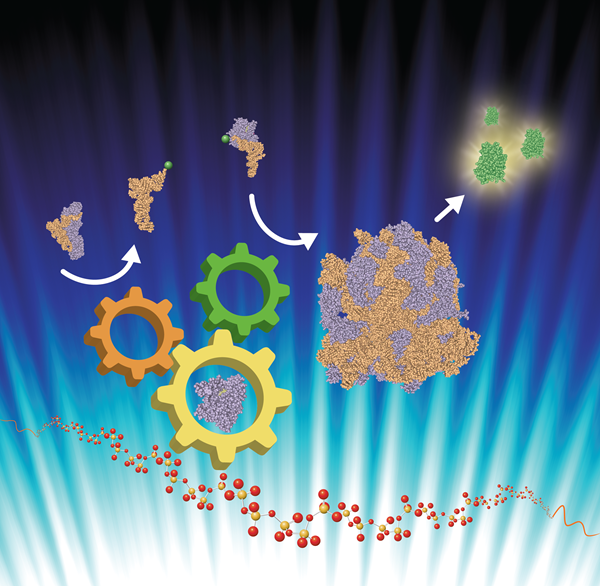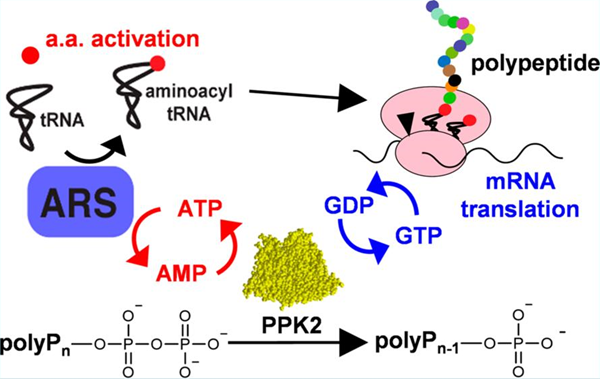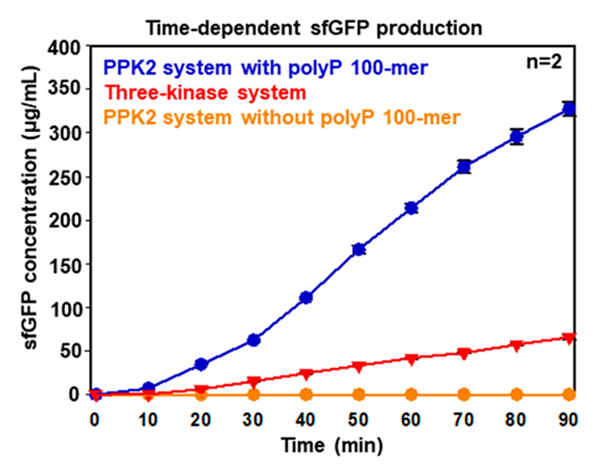Reconstituted cell-free protein synthesis systems allow the expression of toxic proteins, hetero-oligomeric protein subunits and proteins with non-canonical amino acids in the absence of cells. In these systems, an artificial ATP/GTP regeneration system is required to drive protein synthesis, which is accomplished using three kinases and phosphocreatine. Here, ELSI researchers and their collaborators have demonstrated the replacement of these three kinases with a single bi-functional polyphosphate kinase that phosphorylates nucleosides in an exchange reaction from inorganic polyphosphate, a proposed primordial energy source. The single-kinase NTP regeneration approach developed herein could resemble the early stages of bioenergetics required for the formation of protocells on Earth.

Figure 1. Polyphosphate is used for ATP and GTP recycling to drive translation for GFP synthesis.
Credit: Lucy Kwok/ELSI
Reconstituted cell-free protein synthesis systems (i.e. PURE system) derived from reconstituted purified protein and RNA components allow the functional expression of diverse proteins, including those with non-canonical amino acids in the absence of cells. Therefore, the PURE system has been applied to study protein synthesis in various synthetic settings including artificial cells.
In mRNA translation, formation of the peptide bond is carried out by consuming one ATP for tRNA aminoacylation and two GTPs for aminoacyl-tRNA delivery and ribosome translocation. In contrast to cellular organisms that have intrinsic biochemical pathways to regenerate these energy currency molecules, regeneration of ATP and GTP in the cell-free system requires an artificial NTP regeneration system using multiple kinases and substrates.
Family II polyphosphate kinase (PPK2) is a family of phosphotransferases capable of transferring the phospho-moiety of inorganic polyphosphate (polyP) to nucleoside mono- and di-phosphates using metal cations as their cofactor. PPK2s are capable of phosphorylating both nucleoside mono- or di-phosphates.
In this study, the ELSI researchers used a combination of polyp and highly active class III PPK2 from Cytophaga hutchinsonii, CHU0107 (ENA accession ABG57400), to drive protein synthesis in the PURE system. We found that this bi-functional PPK2 is capable of regenerating ATP and GTP in the cell-free condition and revealed an outstanding protein production rate. This new energy regeneration system was also compatible with expressing heat-sensitive luciferase at 37oC.
Energy delivery is a critical aspect in life. The single kinase-based system described herein simplifies cell-free protein synthesis, with a desirable protein yield. Given that polyP is a ubiquitous and ancient energy source as well as an active metabolic regulator for all cellular organisms, incorporation of the PPK2-based NTP regeneration system into synthetic biomembrane vesicles could lead to artificial cell and proto-cell systems more akin to their natural counterparts.


| Journal | ACS Synthetic Biology |
| Tile of the paper | A bi-functional polyphosphate kinase driving NTP regeneration and reconstituted cell-free protein synthesis |
| Authors | 1Po-Hsiang Wang, Kosuke Fujishima, Samuel Berhanu, Yutetsu Kuruma, Tony Z. Jia, and Shawn E. McGlynn 2Anna N. Khusnutdinova and Alexander F. Yakunin |
| Affiliations | 1. Earth-Life Science Institute, Tokyo Institute of Technology, Japan 2. Department of Chemical Engineering & Applied Chemistry, University of Toronto, Canada |
| DOI | https://doi.org/10.1021/acssynbio.9b00456 |
| Online published date | Dec 12, 2019 |
